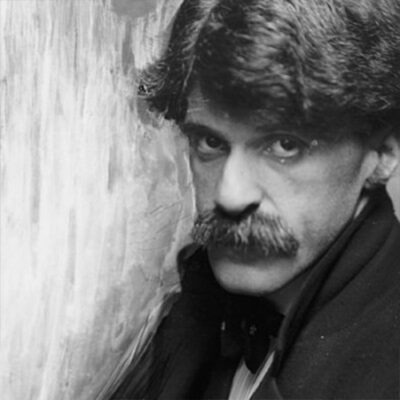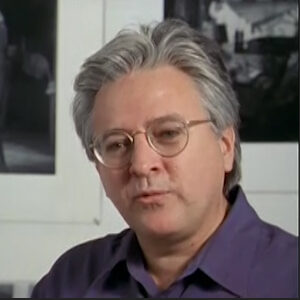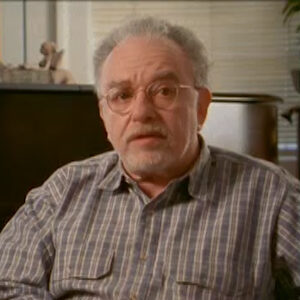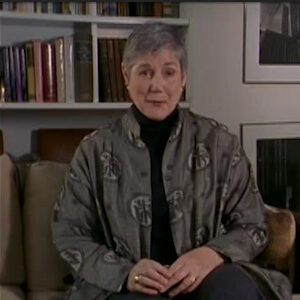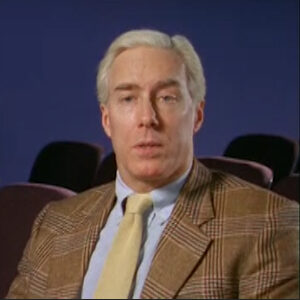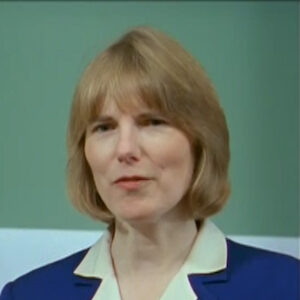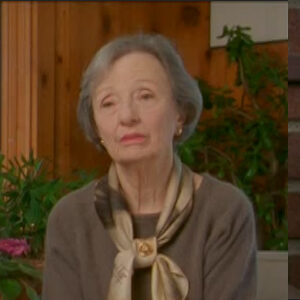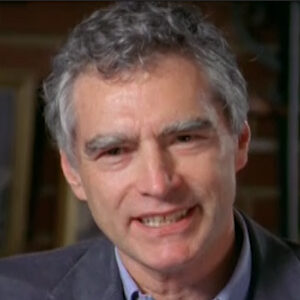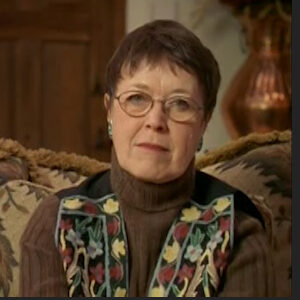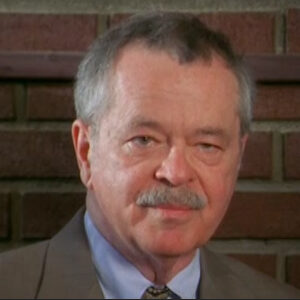Interviewer: Paris.
Turner: Well, when Arthur Dove went to Paris, it was a really important moment for him. He had earned enough money as a professional illustrator in New York to declare himself a free man. And he did exactly what his heart desired, and that was to declare himself an artist. And in those days, to be an artist, you went abroad and you went to Paris. Now, Dove, the other factor about Dove that you need to know is that Dove was very independent, always was, and continued to be throughout his life. So when he went abroad, he immediately headed out to the countryside.
Turner: He headed to the south of France, where the light was so divine and where he could begin to experience the colors in his paint and did begin to describe the effect of the landscape upon him. So he spent a good portion of his time abroad in the south of France, away from the city, away from the politics of Paris.
Interviewer: Could you tell us something about this? This contradiction is interesting. Could you start of there’s an interesting contradiction.
Turner: Well, Paris and Dove is an interesting contradiction. He went to Paris and he was in Paris at a time when the avant garde was opening up full blast. And he could have gone to Gertrude Stein’s Rue de Philip Glass. He could have seen the SAYES on retrospective. He could have been at the Italy of Matisse.
Turner: But he wasn’t he wasn’t any of those places. But he had very good friends who were and the main friend that I’m thinking about, the main person that was so important for Dove at that moment was Alfie Marr.
Turner: And now Femara was at all those places Alfie Marr convey to Dove the moment and the significance of the moment in Paris and before Dove left Paris.
Turner: He had painted important still life compositions which had conveyed the importance of Matisse, conveyed the importance of says on and mixed them impossibly with these impressionist colours and full of colours.
Turner: And these wild early compositions really do show that he was open. He was open to seeing in a new way.
Interviewer: Could you tell us a movie? What he was he the film here? How did he happen to get a closer look at it as he was his first year?
Turner: Well, because of the contacts he had made with these young American artists in Paris. He became known to Stieglitz. And he was included in an important exhibition in 1910 of young American artists. And so Dove Dove came to Stieglitz, his attention at that moment. And it was in contact with when he became in contact with Stieglitz, that he felt further the permission to be himself, to become the artist. He had always wanted to be to invent something new, something for himself and for America.
Interviewer: Could somebody say something about how unusual his abstraction was?
Turner: It was unusual. There’s almost no explaining how or why this wasn’t his first abstraction. Dove’s first abstractions were unusual. There’s almost no explaining how or why he came to it, seemingly. But soon after the show of his work at the at the two nine one gallery in 1910, he goes off again. He leaves the city. He goes camping in the Geneva woods, he says. He said that all along while he was in Paris, he was homesick for those woods thinking about those woods. And he abandons the full palette. He abandons those influences that he had been open to. And he picks a very limited palate’s greens and browns. Earth tones limited to two or three forms. Two or three colors. And he begins to paint the moment that nature awakens to him in the most simplest direct manner, almost embarrassingly simple, to forget all of that training. And he was a university trained artist to forget all of that wonderful forgetting, to find himself to find the forms that really meant something to him. And the uniqueness and the originality of that invention stunned New York, stunned Stieglitz, who declared him the first abstract artist. Cut.
Interviewer: Oh. Oh, this.
Interviewer: So go ahead.
Turner: Well, Dove was was a supreme, independent artist. When I think of an analogy for Dove, I think of Stuart Robert Laura Stevenson’s cat who walked his own way. Dove walked his own way on compromising nothing, even at the moment of his great breakthrough in New York, where he is finding success in the beginning of the decade of the teens.
Turner: He walks his own way and he is living in Westport, Connecticut. He’s working a chicken farm. He is putting in 12 hour days heavy manual labor. There’s very little time to work and to pursue many of these breakthroughs. And yet he is his own person. He is in contact with nature. And so you have to ask the question, is he an artist in spite of being a farmer or is he a farmer because he’s an artist?
Interviewer: Well, why did he go that far? I mean, because he needed money. Why did you go? Why was he for me?
Turner: Well, the story that Stieglitz loved to tell was that his father was the dove’s father believed that when Doug became an abstract artist, that he had completely abandoned his senses and that he would never make a living and was on hopelessly on the wrong track. And so he disinherited him. So Dove was was really without resources. And it was Dove’s choice to find a profession that put him in contact with nature. He, interestingly enough, avoided going back to the very thing that had made him so successful in New York in the beginning, which was illustration.
Turner: He was a very prominent illustrator in New York and he ended up abandoning that in favor of this life of a farmer with very taxing manual labor, but contact with nature, the embrace of the life of an outdoorsman.
Interviewer: What did he give you? Start painting. Didn’t you say that he was so worried that he would sell a painting?
Turner: Well, he he did, in fact, not produce a great amount of work from that time period. There is a great breakthrough show of 1912 where he has a group of pastels, abstractions, pastels, abstractions, and so that he becomes famous for those. But after that point, you find the work mainly in charcoal. His work in oil is in. His production sparse. It’s little wonder that Stieglitz despaired, saw the farming interfering with the work, not knowing, though, how to help.
Interviewer: Put it OK. Left, left, left, left. That’s OK. Paul.
Turner: I wanted to say a little bit more about the idea of Dove as an artist and an outdoorsman. His selection of perspectives is phenomenal. And in this regard, I mean, you really can see him as not a reporter of nature, not a describer of nature, so much as a poet of nature. He’s selecting and emphasizing certain pattern, certain forms that he finds. And he finds them in in a manner of his own experience, standing in a stream, looking down, seeing the rush of water, follow around him, the patterns, how that creates his immersion.
Interviewer: If it were as it was, then his immersion in those zones again. OK. And then the wonderful, wonderful, wonderful you standing in the water, looking down.
Turner: That was a kind of perspective that Dove enjoyed, finding himself immersed in nature, nature of the immersion in the water, finding those patterns, hearing the sound, wanting to convey it all, wanting to convey the sense all to all the senses to have his art open to all of that and to make it known through the color combinations or the rhythm and the transition between one form to the next.
Turner: This was what he wanted to show. This was what he thought was new, his invention, the unfolding of himself through his art.
Interviewer: Wonderful. Oh, there was a story that you wanted to tell. I’m trying to remember now. Yes. Um. I can’t remember.
Turner: Oh, this story. This was the story. What what do we want to watch?
Interviewer: Well, you want to say something about how we all got here.
Turner: It is the story of how these three paintings arrived at the Phillips is. It is a wonderful story. Can I move? Should. OK. All right. So I can move. I can be Martha Stewart.
Turner: You. OK. OK.
Turner: All right. The story of how these three paintings arrived at the Phillips is the Phillips Collection and into Phillips’s hands. It is a wonderful story. Philip Duncan Phillips goes to Stieglitz, his intimate gallery, in 1926, January 1926, and he goes there specifically to find the work of Arthur Duff.
Turner: Arthur does paintings. As I said before, Arthur does paintings were few and hard to come by. And here, when Stieglitz has opened up his intimate gallery, here was the place where he was going to see a whole roomful of paintings by Arthur Doerr, an artist that intrigued him. He could easily see the connection between Dove and the artist in his collection. He could see the connection between Dove and Ryder. He could find the invention and the independents there. And finding that continuity, seeing that dialogue across the generations of American artists was tremendously important to him in building this collection of art. And so in going to the intimate gallery, he finds the painting of Dove. That was the painting of his dreams.
Turner: And naturally, it’s the smallest one in the show, one that would be fit for an intimate gallery that Phillips was building in Washington, an intimate collection that Phillips was building in Washington. That little painting waterfall had captured his eye. And it was his heart’s desire to have it. And it was Stieglitz is in position to tell him that he couldn’t he couldn’t have this painting.
Turner: It belonged to someone else, someone who had sacrificed for the cause. Someone who had given his all naturally wouldn’t name him.
Turner: But he wanted to have him understand just what the price would be to really enlist, enlist in this whole idea of becoming a part of the Stieglitz circle.
Turner: So, Phillips.
Turner: Is engaged at this point. He’s engaged in a dialogue that would take him down a road of conversations that would last more than 40 years. And so that he he says, all right. I can’t have the painting, but perhaps I could borrow it. And so he does for an exhibition at his museum in Washington. And he also leaves that day with two other works, a work called Golden Storm, which was not a bad consolation prize. Golden storm being a work from the 20s, but having many of the earliest signal forms of doves, abstraction, the very angular wave like patterns and the very inventive idea of using metallic paint on a wood board and you letting the grain convey the action of the earth and the sky and the water mixing in this melee of the storm is in this.
Turner: The little painting waterfall eventually came into the collection after a flurry of correspondence and letters in which Phillips declared himself pulling in or in Stieglitz, his cause in their cause.
Turner: This idea of creating and developing American culture, supporting living artists. And Phillips says museum would certainly convey this to generation after generation of Americans.
Turner: The little painting waterfall came in at the same time he acquired the first painting by George O’Keefe to enter a museum collection. This painting, entitled My Shanthi, which is is a painting of Georgia O’Keeffe studio, which floats in the lush green of Lake George. Like a like a boat in the thinned down paint of her marvelously inventive color and form.
Turner: She, like Dove, shared a wonderful eye for invention, eye for pattern, eye for resonances and harmonies in nature.
Interviewer: How did she feel about this? Oh, sorry.
Turner: Well, O’Keeffe’s palette wasn’t necessarily the same as doves, but her interest in nature war was very similar to doves faces. Oh, OK. All right. All right. OK.
Interviewer: OK. OK. Tell us something about. OK.
Speaker Well, O’Keefe and Dove shared a great interest in nature and in seeing themselves as wonderful poets of local realism. They would take the ground, the earth under their feet and find the meaning in it, find the essence of their experience of all the elements of sky and earth and air and water and fire, the fire, the light that enlivened their palette. They would find the line of focus, a line of pattern, energy of nature in the spiral, in the repeating angles of the wind.
Interviewer: Sorry, I went to work and went to a dead end there. OK.
Turner: Both were poets. Both O’Keefe and Dove were poets. And it was through the line of attention that they gave to nature in finding the form in the pattern of rippling water or in the undulating of the hills or the heat, the energy, the spiraling heat of the sun that they you felt the motion of the earth. So it wasn’t a description, an exact description of nature that they wanted, but rather the energy, the force that was conveyed to them through their senses. And it was their ability to focus and marshal their medium to convey that idea, to convey those emotions that made them the great inventors that they became. And in that, they shared a great deal with the visionary work of Albert Pinkham, writer who himself defied traditional categories and inventions, and through his wonderful understanding of contrasting light and form and the mysteries of nature, conveyed something new for these younger artists.
Interviewer: Who do you think was maybe about candidates? Was Kennedy’s calls for both of them? Was he for also?
Turner: I believe Kandinsky was an influence on both Dove and O’Keefe, perhaps at different moments. But for both of them, there was a sense of affirmation in Kandinsky. You might even call it a call to action in Kandinsky, a permission given to them to convey in their paintings the rhythm of color, the essence of form, to know that these were valid subjects and that, in fact, the great painting that they were doing really had to do with their own. The great painting that they were creating really had to do with the forms that they were finding in their own imagination, the way that experience translated through their materials, their medium, their method, their paint.
Interviewer: Oh, OK, fine, fine candies.
Interviewer: Where did you read about it? First, tell us something. You can work Stigler’s publishing it.
Turner: Well, it is interesting that the first trend is certain. It’s interesting that the first translation of Kandinsky really comes in camera work for most American artists. Stieglitz reads it in the German and then translate it set for his readers in camera work. And then one most likely thinks that O’Keefe and I’ve read it there. Although by 1914 and certainly by 1915, there was a complete translation of Kandinsky for American artists, for American readers in New York particularly. And we know that O’Keefe had read Kandinsky while she was a student at Columbia University in 1915, didn’t send her send her the book.
Turner: Because he said he sent her a copy of the book that I don’t know.
Interviewer: So is that is that what is in the book he writes to post about?
Turner: No.
Turner: Well, they. The fact that she’s on her second reading of Kandinski in the fall of 1915, the fact that she is reviewing it and and looking at it in the pages of camera work while she’s teaching in Columbia, South Carolina, and at the very moment that she is going to create her her revolutionary abstract charcoals in in the late fall. And she looks to Kandinski that as a call to action, he says that an artist must listen only to that inner voice, the sense of inner necessity awakened to those ideas. And so it’s at that moment in reading Kandinski, that O’Keeffe’s says, I’m going to paint my colors, my forms, my emotions. They are going to be the subjects of my work. And she finds the courage to break free. And as she says, forget the lessons of the academicians, forget her conventional training, and begin to free up her form two strokes of the whole arm, spiraling forms that begin to open up the flow of her emotion and her meaning her.
Turner: OK.
Turner: Merican abstraction really has its own background, its own set of sources that certainly ignite with the catalyst of Kandinski and importantly or perhaps most importantly, was the book of composition written by Arthur Wesley Daou. This book of composition was a set of exercises, was not did not promote a style, but rather an approach to art. And when O’Keefe first learned about this new approach to art, it it re ignited her own thinking and brought her back to painting. She had stopped painting for four years and had really abandoned the idea of becoming a professional artist. But when she read Dhows Book of composition, when she became incontact, when she came in contact with Dows, teaching this idea of filling space in a beautiful way, thinking about art more abstractly, thinking about the artist in charge of his or her own creation, the idea of being in charge of the elements of style, thinking abstractly about painting, Dao said the death of art is realism, that art is not description. Art is not nature. Art is about the artist’s power to create. And the idea is to reach that power. The power lies within and it has to do with the mastery of those elements of line and form and filling that field of composition. When O’Keefe started thinking about the canvas as a field of composition of field to be filled in a beautiful way, this idea of harmonizing space, dividing space, developing and unfolding space, the artist’s mind and imagination and attention, then filling that space. What freedom she gained. It was it was a new freedom for her. It was an of the power to invent and to create something all her own.
Interviewer: Okay, relax, relax, relax, gentlemen, okay.
Interviewer: About Carbone’s a little bit about that.
Turner: Well, at the heart of Dao’s lessons was this idea of appreciation, appreciation for cultures worldwide, appreciation for seeing the art and the composition and the power of design and all manner of materials of breaking down the boundaries between decorative and fine art.
Turner: And seeing as in Japanese culture, the lack of distinction between the art of everyday and the art of the grand collections and palaces of the museums of the Emperor. So that there would be, in a down vision, a culture in which art could be found in the everyday. So he looked to Japanese art as a tremendous importance. He looked to the approach of the Japanese artist as a as a model for American. This revolution that he saw on American culture, the way it could come when someone would care. When artists would care about seeing and selecting. About noticing the positive value of space. Of seeing the space in their work as being a positive factor, not something empty and neglected, but rather the value of dividing space or seeing symmetry and rhythms in space the way a Japanese artist would see this in his or her compositions.
Turner: He also was interested in Chinese or Chinese.
Turner: And and of course, the model for Japanese painting came in the ancient dynasties of the some dynasties and the their teachings, the way the Japanese preserved the teachings of the Zen scholars and artists, the way they preserved a reverence for method and focus and attention to detail and attention to composition, the way of being informed by asking questions before nature and in front of nature.
Turner: And apart of all of that, that comes with seeing and selecting it was in Japanese and Chinese.
Interviewer: Well, the basic text of Dao’s course at Columbia was, Fenelon says, Epic’s of Chinese and Japanese painting.
Turner: And she kept this book with her her entire life. This book became the core of a library or a book room, as it was called, an abiquiu, which contained many, many volumes relating to and pertaining to Japanese art and oriental culture. She was very interested and read and made notes in the margins of books such as Lawrence Finian’s Flight of a Dragon, which speaks about the importance of space and thinking about space. The value of that. So it’s this Western appreciation for Oriental art that helps to form a basis for her understanding of form for this idea of abstraction, which then marries with the teaching of Kandinski, which became the catalyst, the call to action that these forms, this space, that color could become the subject of her work.
Interviewer: Doing all right.
Interviewer: All right. In television, these cameras outside, outside an.
Interviewer: If we don’t get it, settle down.
Interviewer: OK. Down. Duncan Phillips and.
Turner: Well, Duncan Phillips supported Arthur Dove. Starting in 1930, he had been collecting his work since 1926. So Duncan Phillips had been collecting Arthur Dove’s work since 1926. And in 1930, at the time of the Great Depression of Phillips then began to make his support on a more regular basis in the form of a monthly stipend. And it’s quite interesting because as Phillips saw this as an advance on future payments of four paintings, Stieglitz saw this as an artist’s annuity. And in his correspondence with Phillips, he would say, thank you for the annuity. This will now allow Dove to live. This will allow Dove to create. And so, in a way, Phillips started on this relationship with Dove, which lasted until doves death in 1946. And it was something that they women stop.
Turner: I can’t I’m I’m having trouble focusing my thoughts.
Turner: One stuff could count on this regular support. It really did allow him to begin to focus his energy and to look into oil painting with a greater degree of seriousness. He began to experiment with oils. He began to develop his ideas about color in oil and embark on a great adventure for him. While he had been inventing in the forms of assemblage earlier on, now, with the ability to be settled and supported, he would be able to explore more deeply his love of oil paint.
Interviewer: Could you tell us something about sort of literally all the things that speakers and Phillips had in common? As far as.
Turner: Well, I think both Phillips and Stiglitz were fiercely devoted to the future of American modern painting. I think they believe that it had yet to fully mature and they had wanted to see this happen. Stieglitz by supporting the remnant of those young Americans that had been at his gallery to nine one in his focus and his devotion of Dove and Marrin and O’Keefe and Hartley, that those by selecting those four and Stieglitz far and scuse me and Phillips by supporting those four artists, would also follow and support who those whom he thought were the greatest American painters, something imposed on his work.
Interviewer: OK.
Turner: John Merren, like all American artists of his generation, look to Paris as the center of the art world and as a young American in Paris in the first decade of the 20th century, he made the grand tour. He looked at the great monuments and he came home with portfolios of etchings, etchings of these portals and and facades. And these were were quite popular. And he was making a wonderful living doing this. He was making a name for himself doing this. What Stieglitz did was take a look at this marvelous eye, this wonderful talent, this nervous line generated from this young artist. And then he said, you can do more. And he saw the potential in Marin to capture in that line. And the rhythm of his side and the coordination between eye and hand, the energy that was to be New York. And it was Marin’s great gift to that generation then to look out in the city and to begin to liberate his line and find his line moving in the staccato rhythm of the modern city of the machine age city. And to begin to, in many ways, humanize it with the poet’s touch to allow the Kardos and the highlights and the breaks and the continuity’s all to come together as he saw it, as he felt at the Woolworth Building, standing on its ear, as O’Keeffe once said, so that he was able to capture that energy that was to be modern.
Turner: America was his favorite subjects.
Turner: Well, one of Marin’s favorite subjects was the Brooklyn Bridge. And you look through the great pointed Gothic arches that perhaps might remind you of the old world and yen. And yet when you see the wonderful girders and the tension of those stretched lines that support the great span, you realize the great drama of space that this steel and this frame are actually leaping across this space. Marin wants you to understand the the energy and the excitement of seeing that and experiencing that in the city and watching that grow and develop and work in concert with the skyscrapers that begin to rise up.
Interviewer: So after that, to him, he started doing that, didn’t do much of that. Well, maybe you might mention the series. You can maybe go to the. Let’s see. All right.
Interviewer: Yeah. Our focus for. This is a continuing one. Let’s get some sleep, OK?
Turner: Marin’s ability to connect with a place to give a sense of place at the moment where he was standing and his point of view. His vision was was quite his own, all his own. His sense of place is understanding. When he leaves the city and he turns to the countryside in Weehawken and he sees the landscape and he begins to translate this idea of the rhythm of his strokes, the idea of the view and the distance and his ability to bring the far away near by his understanding of that first coming to him.
Turner: As he gazed up at the bridge in the skyscrapers in New York and then translating that that rhythm of line and impulse to the countryside was a great gift to American modernism.
Interviewer: Thank you so much for his bravery.
Turner: You know, he he traveled and and where his I led him was.
Turner: It is interesting. He went up the Hudson. He he painted the back of Bear Mountain. He also looked to Maine. And it was in Maine that he found his own real spirit, a spiritual home in Maine. He found a spiritual home in Maine. In fact, he lived where he lived on Deer Island, where he had his studio. He could gaze out into the ocean and mark the rocks in the distance with his brush. He could then frame the view, cut the view, really, with these marvelous rhythmic slashing strokes, as if viewing from his window, the window of his studio gazing out across the ocean. He the light in the line of Maine, his ability to do these washes, working with really with the brushes with both hands was it was an amazing gift. His ability to translate vision and impulse seeing and creating. It was Marin’s great gift.
Interviewer: Just let me come for some. I don’t know, I to go into the point. OK, here we go with it. Get it right. OK.
Turner: In his Weehawken series, you can see that is ahead of his time, really noticed those strokes, how they how they build up and cut across the picture plane, how he looks into the marshes of Weehawken and how he he finds the spaces and the forms he gives definition.
Turner: Marston Hartley was born in Maine and he in many ways created his best paintings. They’re both at the beginning and at the end of his career, it was Hartley’s great journey in life to to start and to and in Maine. He was very interested in the modern form of expression, very interested in exploring the language of color and form and making the poetry of that color and form his own, his own meat medium of of insight so that he had always looked to Paris and the avant garde influences of the Parisian of en garde as a way of liberating himself. He wanted to Hartly wanted to go to Paris. So he eventually was able to do this in 1912.
Interviewer: Could you tell us that he managed? Well, you got to know and you want to ninety one minutes before he, which occurs, have a chance to see the notices because. Their influence on him.
Turner: Short of going to Paris, he could go to two nine one and two nine one provided him with the insight about the artists that had who had themselves form their own great new stylistic languages. He was able to see Matisse. He was able to see Picasso on Roedad. He was able to see the great breakthroughs of cubism so that he understood that in breaking up form and allowing the language of the brush to speak on its own to translate the impulses of the artist that he in turn could find his own. You see this first in his Mountainview landscapes where he begins thatching his brush strokes of color.
Turner: And then when he finally does go abroad, when he finally does get to Paris and meet, so an entirely exciting international group of artists, he explodes. He explodes in creativity. He explodes with new colors. He begins to create emblematic forms.
Turner: He’s able to create and invent still life compositions that have tremendous haroun dick significance for the modern movement, particularly for the American modern movement. He does his German officer series, which form the most important abstractions and monumental abstractions of any American artist to date. And in his correspondence with Stieglitz, there is a very, very familiar refrain.
Turner: Come home, come home, come home.
Turner: The room is waiting for you. Come home. This is Stieglitz saying, yes, you are free. Yes, you’ve created. Yes. There’s important to work to do. But your statements need to be made here at home for the benefit of you, for the benefit of all of us. We need to see your work. And so it would go over the course of Hartley’s career, over the course of Hartley’s lifetime. This tug of home. This idea of place. And weighing that and balancing that against his wandering, lustful desire to invent and create and to push further. Could he wander from home and still remember? And so we have many New Mexico recollections from Hartley’s career. Or did he need to be planted firmly in the place to make that connection? These are all questions, questions that Hartley needed to resolve for a time. He lived in season’s studio in the south of France, making for himself, making himself an heir to seize on painting Suzan’s mountain set. And in showing his work from France at Stieglitz, his gallery, Stieglitz would tell him things that he didn’t want to hear. He didn’t want to hear that these paintings did not have the contact, did not have the connection that with America, with Stieglitz would say this. And he would. He would want Hartley to understand that his connection needed to be made at home. And so, Hartley. In the end, would go to Maine and he would make those grand statements about the Maine woods, he would gaze out to the ocean and he in the visionary night and in the light that flashes against the sea from the moon, and you would see the water crashing on on angry rocks and you would begin to see something of the drama, the drama of Hartly soul, the tug of home, the desire to be planted. The restless desire to search.
Interviewer: Very nice, very, very nice. Could you tell us something about the lasting quality? I think that’s sort of you asking me that, which is his Baathists lasted and gained the reputation recognition. So much has happened. Can you tell us something, the justification for his concentration on these Zionists?
Turner: Well, it was Stiglitz is great gambler’s hunch that if he in if he could invest his hope and his support in these young Americans in Hartly, in Dove in O’Keefe in Marin and say, here is where I will put my efforts. It’s with these young artists. It’s in my desire to see them grow and develop. It’s not enough for them to just have a flash of insight, to have a sense of one invention. They did not form of move a movement per say. They were for very gifted individuals. And if somehow through his efforts, he thought if he could allow them to mature in a modern idiom, to become themselves, to develop in their own way, that they would make a lasting contribution. And in fact, American culture would have a new identity, a modern identity.
Interviewer: And if been criticized from punching through those four.
Turner: And he has been criticized for choosing only those for why those four. And yet it was his choice to go deeply, go deeply into the lives of four artists to see that they could live and mature, to provide them with interested supporters like Duncan Phillips to allow them to receive the annuities that gave them the chance to live and be and identify with the American place to provide this as a legacy for generations to understand something more about their own American identity.
Interviewer: Could you tell us, looking now from the end of those two, though, those always and now they have been kind of disappeared, or have they become more.
Turner: And in the end, Stieglitz was right. This at the end of the 20th century, the beginning of the 21st. We see now that he was he was right to invest himself and his efforts in those artists. They stand tall. Their stature is growing. We begin to understand their body of work as a whole. We understand what it is to mature in a modern idiom, that it’s not all about a movement, one movement or one breakthrough, one moment that then dies away. It’s about living and breathing, about knowing and expressing. It’s about becoming something all your own.

